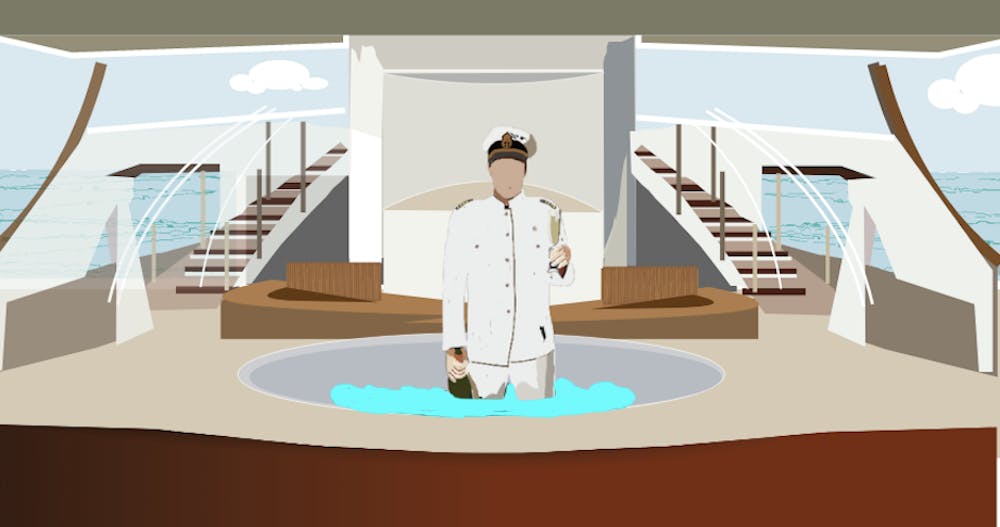Power is typically predicated on factors like wealth and gender, but when everything goes awry and status no longer matters, power can come from unusual places. “Triangle of Sadness” — written and directed by Swedish filmmaker Ruben Östlund — uniquely and bitingly tackles social roles on a luxury yacht filled with the ultra-wealthy.
The film — which won the Palme d’Or at the 2022 Cannes Film Festival — is broken up into three parts. The first part follows Carl and Yaya, two wealthy models in a rocky relationship with each other. Carl is irritated because he always pays for Yaya’s dinner even though she makes more money than he does. On the way home from a date, he voices his displeasure to her, saying he doesn’t want to conform to conventional gender roles — he wants an equal relationship. Östlund employs the long shot in this scene and throughout the entire film, letting us see every subtle facial expression and feel every uncomfortable silence.
Carl and Yaya’s discussion about gender roles sets the table for the rest of the film and its commentary on how different social statuses give certain people power. The couple receives an invitation to a luxury yacht, setting the scene for the second part of the film. Immediately, the division between the workers and the passengers is clear. Along with Carl and Yaya, the ultra-wealthy passengers include a Ronald Reagan-loving Russian oligarch, a hand grenade manufacturer from England and a German woman who, due to a stroke, can only speak the words “in den wolken.” The captain of the ship — hilariously played by Woody Harrelson — seems too drunk and too negligent to be in charge of a yacht. The head of the crew, Paula, has to repeatedly knock on the door of his chambers to remind him to do his job.
In the most memorable scene of the entire film, the passengers gather for a fancy dinner where they get to meet the captain. Unfortunately, a storm hits during the dinner, causing the boat to relentlessly tremble and sway. Östlund’s direction impressively makes the audience feel seasick along with the characters. The camera shakes and turns as the boat does. In the background, doors slam, babies cry and glasses break. By the end of this chaotic scene, not only are the passengers vomiting and defecating, but the audience, too, feels nauseated.
Östlund’s screenplay brilliantly portrays the stark differences in privilege at play on the yacht. In one scene, Carl complains to Paula about one of the workers taking his shirt off. Paula profusely apologizes and calls such behavior inappropriate. Ironically, Carl is shirtless during this scene, and no one complains about it. Obviously, wealth, status and occupation all play into this power dynamic. But when catastrophe strikes the yacht, the conventions of power turn on their head.
During the third part of the film, Carl, Yaya, Paula and several others end up marooned on a remote island and struggle for their survival. Abigail — who cleaned toilets on the yacht -– is the only one who knows how to start a fire. On the first day on the island, she catches a fish and cooks it for dinner. She gives everyone a piece and keeps the rest for herself. Paula criticizes her for not sharing more food; after all, Paula’s occupation has conditioned her to loyally serve those above her. Abigail, having done all the work, realizes she can use her survival skills to take charge and get what she wants out of everyone else.
Everyone on the island must adopt a new social role because of the new dynamics of the situation. Abigail becomes the pragmatic and stern leader instead of a toilet cleaner. Carl – who was frustrated about the expectations of being the “man” in his relationship with Yaya – submissively gives Abigail sexual favors in return for more food. Dimitry – the staunch capitalist from Russia – proposes a system where everyone gets fed, regardless of one’s own abilities. The brilliance of “Triangle of Sadness” comes from how Östlund navigates each character’s reaction to the shattering of all social structure.
“Triangle of Sadness” also delivers so many laughs. In a particularly hilarious scene, Dimitry and the captain drunkenly argue about wealth and taxes over the yacht’s intercom, while everyone else on the boat struggles with seasickness and nausea. The film makes sure to point out the irony of an American communist and a Russian capitalist discussing economics on a billion-dollar boat, as the two men stumble over their words, haphazardly quote the likes of Marx, Chomsky and Thatcher, and fail to notice the people banging on the door to tell them to stop.
With a runtime of two and a half hours, the film could have easily felt bloated with inconsequential moments, but every scene contained fascinating characters, hilarious situations or thoughtful commentary, preventing the film from dragging too much. Östlund’s clever screenplay and nuanced direction make the two and a half hours a riveting watch, even down to the very last shot.







